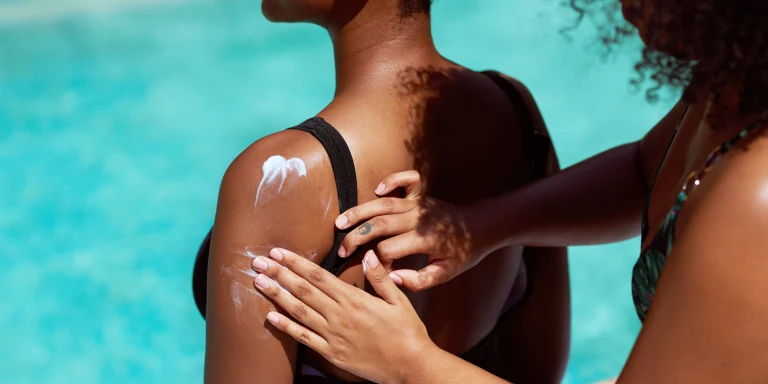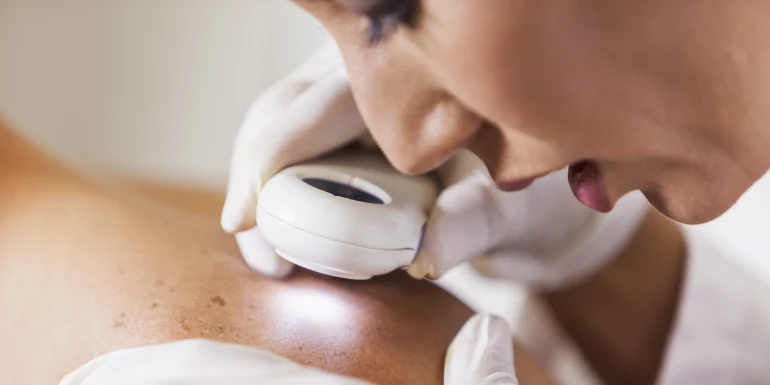
Treat sunburn with home remedies
You can treat sunburn with home remedies like cucumber or aloe vera. But ideally, it shouldn’t even come to that. Find out what different treatment options are available and which parts of the body are most commonly affected.
Home remedies to help treat sunburn
The first thing to do is to cool the sunburn – you could use wet wipes that do not contain any alcohol. You should steer clear of ice, cold packs or quark. These can prolong the healing process. You can apply after-sun products afterwards. If you don’t have any of these products to hand, you can also use normal moisturiser. However, it doesn’t absorb as quickly and has no cooling effect. You can also use the following home remedies to calm sunburn:
Aloe vera
Aloe vera has anti-inflammatory, cooling and moisturising properties. The gel also alleviates itching and helps with regeneration. In addition to aloe vera creams from the pharmacy, the gel from the plant can also be used. Cut a leaf from the plant. Let the liquid drain briefly, then wrap the leaf in cling film and refrigerate it for 30 minutes. Cut off a large piece of the cooled leaf and slice it open lengthwise. This will allow you to scrape out the gel and apply it directly to the sunburn.
Cucumber
Cucumber has a cooling and moisturising effect and can be used to soothe stressed skin. Cut a few cucumber slices and place them directly on the sunburn. The effect is enhanced with refrigerated cucumber.
Black tea and camomile flowers
Steep a black teabag for a few minutes, then put it in the refrigerator to cool. For small burns, you can place the cooled teabag directly on the damaged skin. Alternatively, you can prepare a decoction of camomile flowers. Add five tablespoons of camomile flowers to half a litre of boiling water. Steep the decoction for around ten minutes, then allow it to cool and soak some cloths in the mixture. You can apply these directly to the sunburn. Both methods soothe the skin, promote wound healing and prevent inflammation.
St John’s wort oil
After a cooling effect is achieved with the remedies already mentioned, St John’s wort oil can alleviate pain and help the skin regenerate. The oil also has antibacterial properties and serves to eliminate toxins more quickly. You can apply a thin layer of St John’s wort oil directly to the sunburn, or use strips of gauze that have been soaked in the oil.
Please note: St John’s wort oil increases photosensitivity. Avoid the sun after applying it.
Other essential oils
Other essential oils recommended for sunburn include camomile, lavender, geranium, tamanu, marigold, pomegranate and arnica.
Schuessler salts
Schuessler salts help to bring mineral levels back into balance. There are a variety of different types. Numbers 3 (ferrum phosphoricum) and 8 (sodium chloride) are recommended for sunburn. The salts can be applied to the skin in the form of a cream gel. They are also available in tablet form. These can be taken orally or dissolved in bath water.
General tips for treating sunburn
- Remain in a dark and cool environment.
- Avoid the sun during the hottest time of the day – i.e. between 11 a.m. and 3 p.m.
- Avoid any further UV radiation until the sunburn is fully healed.
- Stay hydrated – your body now needs more fluids.
- In the case of severe burns – i.e. over large areas, or if you have blisters or peeling skin – you should consult a medical specialist.
Commonly affected parts of the body: what should I do if my face is sunburned?
Parts of the skin that are not protected by clothing must be given extra protection. The face is commonly affected by sunburn, with sensitive areas like the lips, nose or eye area. The same applies here: cool the area as soon as possible – ideally with a cooling face cream or a moisturising aloe vera gel.
People often forget that their scalp can also burn. So, protect it with a hat or a special sun protection spray for scalp and hair.
Degrees and durations of sunburn
Sunburn is split into three degrees of severity – this depends on how long you were exposed to the sun and which skin type you have. The degree of severity also affects how long the sunburn lasts.
First-degree sunburn:
Light sunburn causes painful reddening of the skin and skin feels warm to the touch. It can also cause itchiness and swelling.
How long does first-degree sunburn last?
First-degree sunburn generally heals in a few days. The skin recovers within a week.
Second-degree sunburn:
With second-degree sunburn, painful skin redness and itchiness are accompanied by blistering. If blisters appear, you should see your doctor.
How long does second-degree sunburn last?
In this case, it will take a little longer for the sunburn to disappear: the skin is likely to take two weeks to heal.
Third-degree sunburn:
As well as the symptoms mentioned above, severe sunburn is accompanied by significant destruction and stripping of the epidermis. Third-degree sunburn can also cause fever, coldness, nausea and shivering. If this is the case, you must consult your doctor.
How long does third-degree sunburn last?
Severe sunburn takes time to heal. In fact, it can take several weeks to heal fully. Unfortunately, it can also result in permanent skin damage.
Sensitive skin can also react to too much sun with a sun allergy. Find out here how to tell if you have a sun allergy and what you can do about it.
No, although this slightly increases your skin’s own protection factor, it still does not protect you against the negative effects of the sun’s rays. In addition, even UV rays from sunbeds increase the risk of getting skin cancer and make your skin age quicker.
Many people want beautifully tanned skin in summer. The important thing is not to overdo sunbathing, to take breaks in the shade and to protect your skin with a good quality sun cream. If you still get sunburn, you can alleviate this with the right home remedies. Whatever you do, give your skin a break so it can properly recover after sunburn.

The expert provided the editorial team with advice and input for this article. Ilenia Battistella (pharmacist) works for the Helsana health consultation service. She helps customers on issues to do with prevention and health promotion.


Newsletter
Find out more about current health issues every month and get all the information you need about our attractive offers from all Helsana Group companies * delivered by e-mail to read whenever it suits you. Our newsletter is free of charge and you can sign up here:
We did not receive your information. Please try again later.
* The Helsana Group comprises Helsana Insurance Company Ltd, Helsana Supplementary Insurances Ltd and Helsana Accidents Ltd.